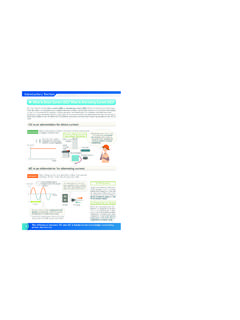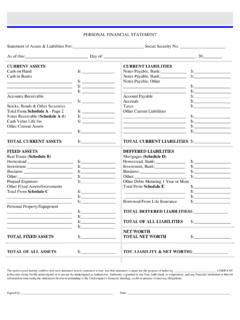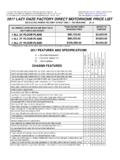Transcription of Solar Geo Intro final - mypages.iit.edu
1 1 Solar Geometry The Earth s daily rotation about the axis through its two celestial poles (North and South) is perpendicular to the equator, but it is not perpendicular to the plane of the Earth s orbit. In fact, the measure of tilt or obliquity of the Earth s axis to a line perpendicular to the plane of its orbit is currently about . We call the plane parallel to the Earth s celestial equator and through the center of the sun the plane of the Sun. The Earth passes alternately above and below this plane making one complete elliptic cycle every year. Winter Solstice (z Dec 21) Vernal Equinox (z March 21 ) SUN P L A N E O F S U N Autumnal Equinox (z Sept 23) Summer Solstice (z June 21 )
2 2 Summer Solstice On the occasion of the summer solstice, the Sun shines down most directly on the Tropic of Cancer in the northern hemisphere, making an angle = + with the equatorial plane. In general, the Sun declination angle, , is defined to be that angle made between a ray of the Sun, when extended to the center of the earth, O, and the equatorial plane. We take to be positively oriented whenever the Sun s rays reach O by passing through the Northern hemisphere. On the day of the summer solstice, the sun is above the horizon for the longest period of time in the northern hemisphere. Hence, it is the longest day for daylight there. Conversely, the Sun remains below the horizon at all points within the Antarctic Circle on this day.
3 Winter Solstice On the day of the winter solstice, the smallest portion of the northern hemisphere is exposed to the Sun and the Sun is above the horizon for the shortest period of time there. In fact, the Sun remains below the horizon everywhere within the Arctic Circle on this day. The Sun shines down most directly on the tropic of Capricorn in the southern hemisphere on the occasion of the winter solstice. We call the Sun declination angle. 3 The Sun declination angle, , has the range: < < + during its yearly cycle . Accurate knowledge of the declination angle is important in navigation and astronomy. For most Solar design purposes, however, an approximation accurate to within about 1 degree is adequate.
4 One such approximation for the declination angle is: o [ Vernal Equinox Autumnal Equinox c o Yearly Variation in Declination Day Number o [ Summer Solstice Winter Solstice/o The Sun declination angle is = on the winter sin = cos [ ( N 173 ) ] ( 1 ) where the argument of the cosine here is in degrees and N denotes the number of days since January 1. Vernal and Autumnal Equinox There are two occasions throughout the year when the center of the Earth lies in the plane of the Sun. Since the Earth s North South axis of rotation is perpendicular to this plane, it follows that on these two days every location on the Earth receives 12 hours of sunshine.]]
5 These two events are known as the vernal and autumnal equinoxes. Note that The Earth is above the plane of the Sun during its motion from the autumnal equinox to winter solstice to vernal equinox. Hence, < 0 during the fall and winter. The Earth is below the plane of the sun as it moves from vernal equinox to summer solstice and back to autumnal equinox ( during spring and summer). So > 0 during these seasons. The latitude of a location on the Earth is the angle between the line joining that location to the center of the earth and the equatorial plane. For example, Chicago, Illinois is on the circle of latitude N. All locations at the same latitude experience the same geometric relationship with the sun.
6 The great semicircles along the surface of the Earth joining the North to the South poles are called lines of longitude. The location P on the globe has longitude East and latitude North. Cities on the same circle of latitude Cities on the same line of longitude The Sun declination angle has measure: = 0 on the days of the vernal and the autumnal equinox. The line of longitude through Greenwich, England is called the prime meridian. 5 Solar Noon Solar Noon is defined to be that time of day at which the Sun s rays are directed perpendicular to a given line of longitude.
7 Thus, Solar noon occurs at the same instant for all locations along any common line of longitude. Solar Noon will occur one hour earlier for every 15 degrees of longitude to the east of a given line and one hour later for every 15 degrees west. (This is because it takes the Earth 24 hours to rotate 360 .) Problem: Determine the elevation angles at which the sun s rays reach the surface of the Earth in Chicago, IL at Solar noon at the times of an equinox or a solstice. At the Vernal and the Autumnal Equinox Thus, the most direct angle at which the Sun s rays strike the ground in Chicago is at about 48 on the days of a vernal and autumnal equinox. 6 At the Summer Solstice Thus, the Sun s rays strike the ground in Chicago most directly at a vertical angle of about 72 on the day of the summer solstice.
8 7 At the Winter Solstice On the day of the winter solstice, the Sun s rays strike the ground at an angle of about 25 at Solar noon in Chicago, IL. 8 It is evident that, on any day of the year, the most direct angle of Solar radiation at a given location occurs at Solar noon. From our previous examples, it follows that for points in the Northern hemisphere, the angle of Solar elevation at noon is given by: = 90 ( ) ( 2 ) The symmetrical formula for Solar elevation at noon for points in the Southern hemisphere is given by: = 90 + ( ) ( 3 ) We have seen that at Solar noon, the range of angles at which the sun strikes the ground at Chicago, Illinois varies from a minimum of at the winter solstice to a maximum of at the time of the summer solstice.
9 A sun path diagram for Chicago appears below. In the above diagram, the azimuth and Solar elevation angles are the coordinates of an observer's local horizon system in Chicago, Illinois. You may obtain a sun path diagram for any specified location on Earth at any specified time of the year by entering the relevant information at the University of Oregon s Solar Radiation Monitoring Laboratory website: . 9 Equator The azimuth is the local angle between the direction of due North and that of the perpendicular projection of the Sun down onto the horizon line measured clockwise.
10 Thus, we have the azimuth values: 0 = due North, 90 = due East, 180 = due South, and 270 = due West. The angle of Solar elevation, , is defined as before, to be the angular measure of the Sun s rays above the horizon. Equivalently, it is the angle between the direction of the geometric center of the Sun and the horizon. Sunrise Equation The sunrise equation: (4) is used to determine the local time of sunrise and sunset at the latitude, , when the Sun declination angle is degrees. In this equation, we have the quantities: = o the hour angle expressed in degrees where 180 < o < 0 at sunrise and 0 < o < +180 at sunset.






